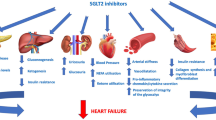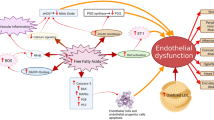Abstract
Several lines of evidence suggest that cyclooxygenase-2 (COX-2) activity can have a beneficial role in the maintenance of vascular tone of the blood vessels in diabetes. Specifically, the increased production of prostacyclin (PGI2) and prostaglandin E2 (PGE2), mediated by COX-2, has been suggested to compensate for decreased synthesis of nitric oxide (NO). The study investigates whether inhibition of COX-2 may reduce the coronary flow in diabetic animals and may also lead to decreased synthesis of prostaglandins. Mice aged 18–20 weeks were used for the study: those with leptin receptor deficiency (db/db) served as a model of diabetes while heterozygous (db/+) mice served as controls. Coronary flow was measured by the Langendorff method, and prostaglandin synthesis by myocardia was assayed in heart perfusates. COX-2 inhibition was found to reduce basal coronary flow in db/db mice but had no effect in db/+ mice. Secretion of PGE2 was found to be higher in db/db mice, while prostacyclin synthesis did not differ. COX-2 inhibition decreased production of both prostaglandins to similar levels in both groups. The use of ONO-1301, a specific agonist for the prostacyclin receptor revealed that vasodilating responses mediated by the receptor were impaired in db/db mice. The expression levels of the receptor in cardiac tissue did not differ between the groups. It is concluded that the increased COX-2 contribution to vasodilation in diabetic animals appears to be partially a result of increased COX-2-dependent synthesis of PGE2 and also may be caused by impaired vasodilation mediated by the prostacyclin receptor.




Similar content being viewed by others
References
Bratkovsky SV, Aasum E, Riemersma RA, Myhre ES, Larsen TS (2006) Reduced coronary reserve in response to short-term ischaemia and vasoactive drugs in ex vivo hearts from diabetic mice. Acta Physiol (Oxf) 186:171–177
Chen Y, Yang S, Yao W, Zhu H, Xu X, Meng G, Zhang W (2014) Prostacyclin analogue beraprost inhibits cardiac fibroblast proliferation depending on prostacyclin receptor activation through a TGF β-Smad signal pathway. PLoS One 9:e98483
Chua SC Jr, Chung WK, Wu-Peng XS, Zhang Y, Liu SM, Tartaglia L, Leibel RL (1996) Phenotypes of mouse diabetes and rat fatty due to mutations in the OB (leptin) receptor. Science 271:994–996
Feletou M, Verbeuren TJ, Vanhoutte PM (2009) Endothelium-dependent contractions in SHR: a tale of prostanoid TP and IP receptors. Br J Pharmacol 156:563–574
Gwozdz P, Drelicharz L, Kozlovski VI, Chlopicki S (2007) Prostacyclin, but not nitric oxide, is the major mediator of acetylcholine-induced vasodilatation in the isolated mouse heart. Pharmacol Rep 59:545–552
Hara A, Yuhki K, Fujino T, Yamada T, Takayama K, Kuriyama S, Takahata O, Karibe H, Okada Y, Xiao CY, Ma H, Narumiya S, Ushikubi F (2005) Augmented cardiac hypertrophy in response to pressure overload in mice lacking the prostaglandin I2 receptor. Circulation 112:84–92
Kobayashi K, Murata T, Hori M, Ozaki H (2011) Prostaglandin E2-prostanoid EP3 signal induces vascular contraction via nPKC and ROCK activation in rat mesenteric artery. Eur J Pharmacol 660:375–380
Lawler OA, Miggin SM, Kinsella BT (2001) Protein kinase A-mediated phosphorylation of serine 357 of the mouse prostacyclin receptor regulates its coupling to G(s)-, to G(i)-, and to G(q)-coupled effector signaling. J Biol Chem 276:33596–33607
Nacci C, Tarquinio M, De BL, Mauro A, Zigrino A, Carratu MR, Quon MJ, Montagnani M (2009) Endothelial dysfunction in mice with streptozotocin-induced type 1 diabetes is opposed by compensatory overexpression of cyclooxygenase-2 in the vasculature. Endocrinology 150:849–861
Nasrallah R, Hebert RL (2004) Reduced IP receptors in STZ-induced diabetic rat kidneys and high-glucose-treated mesangial cells. Am J Physiol Renal Physiol 287:F673–F681
Peredo HA, Feleder EC, Adler-Graschinsky E (1999) Time-course of the alterations in prostanoid production and in contractile responses of mesenteric beds isolated from streptozotocin diabetic rats. Prostaglandins Leukot Essent Fatty Acids 60:269–274
Peredo HA, Rodriguez R, Susemihl MC, Villarreal I, Filinger E (2006) Long-term streptozotocin-induced diabetes alters prostanoid production in rat aorta and mesenteric bed. Auton Autacoid Pharmacol 26:355–360
Przygodzki T, Talar M, Watala C (2013) COX-2-derived prostaglandins do not contribute to coronary flow regulation in diabetic rats: distinct secretion patterns of PGI2 and PGE2. Eur J Pharmacol 700:86–92
Sanchez A, Contreras C, Martinez P, Villalba N, Benedito S, Garcia-Sacristan A, Salaices M, Hernandez M, Prieto D (2010) Enhanced cyclooxygenase 2-mediated vasorelaxation in coronary arteries from insulin-resistant obese Zucker rats. Atherosclerosis 213:392–399
Schermuly RT, Pullamsetti SS, Breitenbach SC, Weissmann N, Ghofrani HA, Grimminger F, Nilius SM, Schror K, Kirchrath JM, Seeger W, Rose F (2007) Iloprost-induced desensitization of the prostacyclin receptor in isolated rabbit lungs. Respir Res 8:4, 1465-9921-8-4
Stabler T, Kenjale A, Ham K, Jelesoff N, Allen J (2010) Potential mechanisms for reduced delivery of nitric oxide to peripheral tissues in diabetes mellitus. Ann N Y Acad Sci 1203(101-6):101–106
Szerafin T, Erdei N, Fulop T, Pasztor ET, Edes I, Koller A, Bagi Z (2006) Increased cyclooxygenase-2 expression and prostaglandin-mediated dilation in coronary arterioles of patients with diabetes mellitus. Circ Res 99:e12–e17
Wilson SM, Sheddan NA, Newton R, Giembycz MA (2011) Evidence for a second receptor for prostacyclin on human airway epithelial cells that mediates inhibition of CXCL9 and CXCL10 release. Mol Pharmacol 79:586–595
Zhu N, Liu B, Luo W, Zhang Y, Li H, Li S, Zhou Y (2014) Vasoconstrictor role of cyclooxygenase-1-mediated prostacyclin synthesis in non-insulin-dependent diabetic mice induced by high-fat diet and streptozotocin. Am J Physiol Heart Circ Physiol 307:H319–H327
Acknowledgments
This work was supported by the grants from the Ministry of Science and Higher Education (No. N401 265839) and the National Science Centre (No. UMO-2012/06/A/N25/00069), partly by the projects POIG.01.03.01-10-129/08-00 and POIG 01.01.02-00-069/09-00, financed by the European Regional Development Fund within the framework of the Innovative Economy Operational Programme 2007–2013, and by a research grant from the Medical University of Lodz (502-64-021).
Author information
Authors and Affiliations
Corresponding author
Additional information
Tomasz Przygodzki and Marcin Talar contributed equally to this work.
Rights and permissions
About this article
Cite this article
Przygodzki, T., Talar, M., Przygodzka, P. et al. Inhibition of cyclooxygenase-2 causes a decrease in coronary flow in diabetic mice. The possible role of PGE2 and dysfunctional vasodilation mediated by prostacyclin receptor. J Physiol Biochem 71, 351–358 (2015). https://doi.org/10.1007/s13105-015-0415-y
Received:
Accepted:
Published:
Issue Date:
DOI: https://doi.org/10.1007/s13105-015-0415-y




